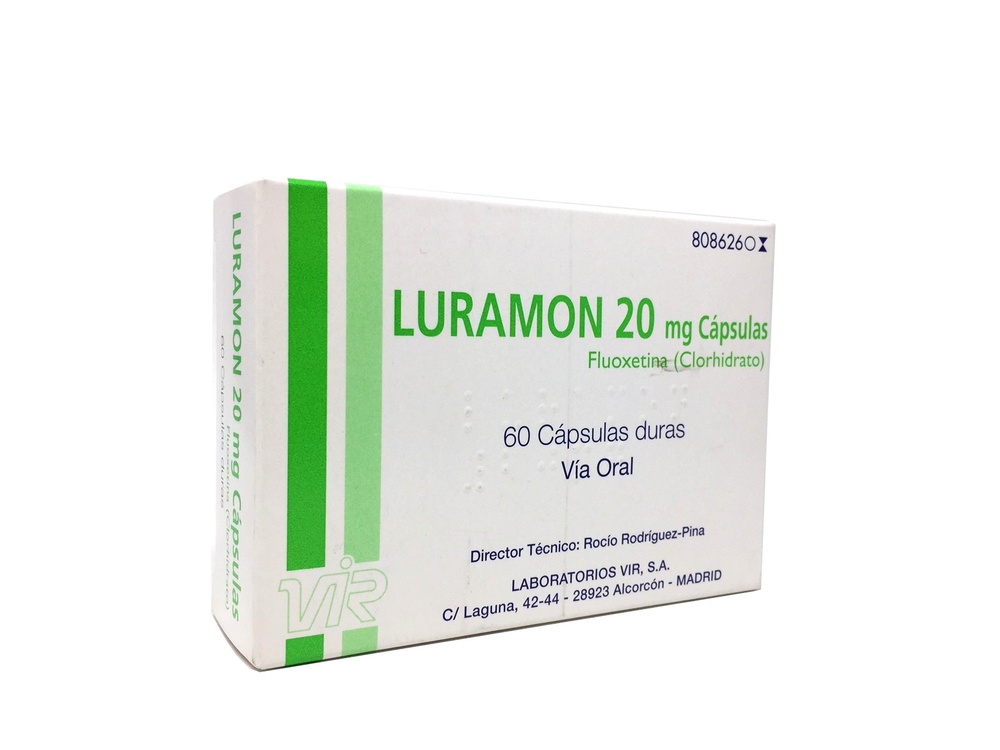

LURAMON 20 mg HARD CAPSULES

Ask a doctor about a prescription for LURAMON 20 mg HARD CAPSULES

How to use LURAMON 20 mg HARD CAPSULES
Introduction
Package Leaflet: Information for the User
LURAMON 20 mg Hard Capsules
Fluoxetine Hydrochloride
Read all of this leaflet carefully before you start taking this medicine.
|
In this leaflet:
- What LURAMON is and what it is used for
- Before taking LURAMON
- How to take LURAMON
- Possible side effects
- Storing LURAMON
- Further information
1. What LURAMON is and what it is used for
LURAMON belongs to a group of medicines called selective serotonin reuptake inhibitors (SSRIs):
This medicine is indicated for the treatment of:
Adults:
- Major depressive episodes
- Obsessive-compulsive disorder
- Bulimia nervosa: LURAMON is indicated as a complement to psychotherapy for the reduction of binge-eating and purging.
Children over 8 years and adolescents:
- For moderate to severe depressive episodes, if there is no response to psychological therapy after 4 to 6 sessions. LURAMON should be offered to children or young people with moderate to severe depression only in combination with psychological therapy.
2. Before taking LURAMON
Do not take LURAMON and inform your doctor or pharmacist:
If you are allergic (hypersensitive) to fluoxetine or any of the other ingredients of LURAMON. An allergy can include rash, itching, swelling of the face or lips or difficulty breathing.
- If you are taking any medicine belonging to another type of medicine used to treat depression, known as non-selective monoamine oxidase inhibitors or reversible inhibitors of monoamine oxidase type A (also called IMAO-A), a serious or life-threatening reaction may occur.
Treatment with fluoxetine may only be started after two weeks after finishing treatment with an irreversible MAO inhibitor (e.g., tranilcipromina).
However, treatment with fluoxetine can be started the day after finishing treatment with certain reversible MAO inhibitors, known as reversible MAO inhibitors, called IMAO-A (e.g., moclobemide).
Do not take any MAOI for at least five weeks after stopping medication with LURAMON. If you have been prescribed LURAMON for a long period and/or at a high dose, your doctor may consider the need for a longer interval before taking an MAOI. Examples of MAOIs are: nialamida, iproniazida, selegelina, moclobemida, fenelcina, tranilcipromina, isocarboxacida, and toloxatona.
An increased risk of bone fractures has been observed in patients treated with this type of medicine.
Be particularly careful with LURAMON and inform your doctor or pharmacist if:
- You develop skin rashes or other allergic reactions (such as itching, swelling of the face or lips or difficulty breathing), stop taking the capsules and contact your doctor immediately.
- If you have epilepsy or have previously suffered from seizures, if you have seizures or experience an increase in the frequency of them, contact your doctor immediately, you may need to interrupt treatment with fluoxetine.
- If you have suffered from mania in the past, if you have a manic episode, contact your doctor immediately, you may need to discontinue the use of fluoxetine.
- If you have diabetes, your doctor may need to adjust your insulin or other antidiabetic treatment.
- If you have liver problems (your doctor may need to adjust your dose).
- If you have heart disease.
- If you are taking diuretics, especially if you are an elderly patient.
- If you are receiving electroconvulsive therapy (ECT).
- If you have a history of bleeding disorders, if you develop hematoma or unusual bleeding or if you are pregnant (see "Pregnancy").
- If you are taking medications that affect blood coagulation (see "Taking other medicines").
- If you start to experience fever, stiffness, or muscle tremors, changes in your mental state such as confusion, irritability, or extreme agitation, you may be suffering from a condition called serotonin syndrome or neuroleptic malignant syndrome. Although this syndrome is rare, it can be life-threatening, so contact your doctor immediately, the use of fluoxetine may be discontinued.
- If you have suicidal thoughts or self-harm. Depression is associated with an increased risk of suicidal thoughts, self-harm, and suicide (suicide-related events). This risk may persist until improvement of the disease occurs. Since it may take 3 to 4 weeks after starting treatment with fluoxetine until such improvement occurs, your doctor will closely monitor you at the beginning of treatment. Other psychiatric conditions for which LURAMON is prescribed may also be associated with an increased risk of suicide-related events. Therefore, the same precautions should be taken when treating patients with other psychiatric disorders. You are more likely to have these thoughts:
- If you have previously had thoughts of taking your life or self-harm.
- If you are a young adult. Clinical trial data have shown an increased risk of suicidal behavior in young adults (under 25 years) with psychiatric disorders who were treated with an antidepressant.
If at any time you have thoughts of self-harm or suicide, contact your doctor or go directly to a hospital.
It may be helpful for you to tell a relative or close friend that you are depressed or have an anxiety disorder and ask them to read this leaflet. You can ask them if they think your depression or anxiety has worsened, or if they are concerned about changes in your behavior.
Some medicines of the group to which LURAMON belongs (called SSRIs/ISRN)
may cause symptoms of sexual dysfunction (see section 4). In some cases, these symptoms persist after treatment is discontinued.
Use in children and adolescents from 8 to 18 years:
Patients under 18 years have a higher risk of adverse effects such as suicidal attempts, suicidal ideas, and hostility (predominantly aggression, confrontational behavior, and irritability) when taking this class of medicines. LURAMON should only be used in children and adolescents from 8 to 18 years for the treatment of moderate to severe depressive episodes in combination with psychological therapy, and should not be used for other indications in this age group.
Additionally, there is only limited information regarding the long-term safety of LURAMON in relation to growth, puberty, and cognitive, emotional, and behavioral development in this age group. However, your doctor may prescribe LURAMON to patients under 18 years for the treatment of moderate to severe depressive episodes in combination with psychological therapy when they decide it is the most convenient for the patient. If your doctor prescribes LURAMON to a patient under 18 years and you wish to discuss this decision, please go back to your doctor. You should inform your doctor if any of the symptoms mentioned above appear or worsen when patients under 18 years are taking LURAMON.
LURAMON should not be used in the treatment of children under 8 years of age.
Taking other medicines with LURAMON.
Tell your doctor or pharmacist if you are taking or have recently taken any other medicines (in the last 5 weeks), even those obtained without a prescription. This medicine may influence the action of other medicines (interaction). Interactions may occur with:
- Monoamine oxidase inhibitors (MAOIs) (medicines used to treat depression). Non-selective MAOIs or MAOIs known as IMAO type A (such as moclobemide) should not be used with LURAMON, as they may cause serious or even fatal reactions (serotonin syndrome), see section "Do not take LURAMON". MAOIs known as IMAO-B (Selegilina) may be used with LURAMON, provided your doctor closely monitors your treatment.
- Lithium, tryptophan: there is an increased risk of serotonin syndrome if these medicines are administered with LURAMON. When fluoxetine is administered in combination with lithium, your doctor should monitor you more frequently.
- Phenytoin (medicine used for epilepsy), LURAMON may increase the blood levels of this medicine, so your doctor should dose phenytoin more carefully when administered with LURAMON and should monitor you more frequently.
- Clozapine (used to treat some mental disorders), tramadol (for pain treatment), or tryptophans (for migraine treatment), there is an increased risk of hypertension.
- Flecainida or encainida (for heart problems), carbamazepine (for epilepsy treatment), tricyclic antidepressants (e.g., imipramine, desimpramine, and amitriptilina), because LURAMON may change the blood levels of these medicines, so your doctor may need to reduce your dose when administered with LURAMON.
- Warfarin or other medicines that affect blood coagulation; LURAMON may alter the effect of these medicines in the blood. Your doctor will need to perform certain tests if you start or stop treatment with LURAMON while taking warfarin.
- You should not start taking herbal preparations containing St. John's Wort (Hypericum perforatum) while you are being treated with LURAMON, as it may increase the risk of adverse effects. If you start treatment with LURAMON while you are taking St. John's Wort, stop taking it and inform your doctor at your next visit.
Taking LURAMON with food and drinks
- LURAMON can be taken with or without food, as you prefer.
- It is not advisable to drink alcohol while taking this medicine.
Pregnancy and breastfeeding
Ask your doctor or pharmacist for advice before taking any medicine.
Pregnancy
Information available to date does not indicate an increased risk when using this medicine during pregnancy. However, caution should be exercised when using it during pregnancy, especially during the last stage of pregnancy or just before childbirth, as the following adverse effects have been reported in newborns: irritability, tremors, muscle weakness, persistent crying, difficulty feeding or sleeping.
In babies whose mothers took fluoxetine during the first months of pregnancy, there are reports suggesting a higher risk of congenital defects affecting the heart. In the general population, approximately 1 in 100 babies are born with a heart defect. This probability increased to about 2 in 100 in babies whose mothers took fluoxetine. You and your doctor can decide that while you are pregnant, it is best to stop taking fluoxetine gradually. However, depending on your circumstances, your doctor may suggest that you continue taking fluoxetine.
Make sure your midwife and/or doctor knows that you are taking LURAMON. When taken during pregnancy, particularly in the last 3 months of pregnancy, medicines like LURAMON may increase the risk of a serious disease in babies called persistent pulmonary hypertension of the newborn (PPHN), which makes the baby breathe faster and turn blue. These symptoms usually start during the first 24 hours after the baby is born. If this happens to your baby, contact your midwife and/or doctor immediately.
If you take LURAMON in the final stage of pregnancy, there may be a higher risk of heavy vaginal bleeding shortly after childbirth, especially if you have a history of bleeding disorders. Your doctor or midwife should know that you are taking LURAMON to advise you accordingly.
Breastfeeding
Fluoxetine is excreted in breast milk and may cause adverse effects in children. You should continue breastfeeding only if it is absolutely necessary. If you continue breastfeeding, your doctor may prescribe a lower dose of fluoxetine.
Animal studies have shown that fluoxetine reduces sperm quality. Theoretically, this could affect fertility, but the impact on human fertility has not been observed yet.
Driving and using machines
This medicine may affect your judgment or coordination. Do not drive or use machinery without consulting your doctor or pharmacist.
3. How to take LURAMON
Follow your doctor's instructions for taking LURAMON exactly. Ask your doctor or pharmacist if you have any doubts. The usual dose is:
- Depression: the recommended initial dose is 20 mg. Your doctor may review and adjust your dose as necessary in the 3 to 4 weeks following the start of treatment. When necessary, the dose can be gradually increased up to a maximum of 60 mg. The dose should be increased carefully to ensure that you receive the lowest effective dose. You may not feel better immediately after starting to take your medicine for depression. This is common, as improvement in depressive symptoms does not occur until after the first few weeks of treatment. Patients with depression should be treated for a period of at least 6 months.
- Bulimia nervosa: the recommended dose is 60 mg per day.
- Obsessive-compulsive disorder: the recommended dose is 20 mg per day. Your doctor may review and adjust the dose after two weeks of treatment. When necessary, the dose can be gradually increased up to a maximum of 60 mg. If you do not observe improvement within 10 weeks, treatment with LURAMON should be reconsidered.
- Children and adolescents from 8 to 18 years with depression: Treatment should be initiated and supervised by a specialist. The initial dose is 10 mg/day. After one or two weeks, your doctor may increase the dose to 20 mg/day. The dose should be increased carefully to ensure that the patient is maintained with the lowest effective dose. Children with low weight may need lower doses. Your doctor should reevaluate the need to continue treatment after 6 months. If you have not improved, treatment should be reconsidered.
If you are elderly, your doctor should increase your dose more carefully, and the daily dose should not generally exceed 40 mg. The maximum dose is 60 mg per day.
If you have liver problems or are using another medication that may affect fluoxetine, your doctor will decide whether to prescribe a lower dose or instruct you on how to use LURAMON on alternate days.
Method of administration
Swallow the capsules with water. Do not chew them.
If you take more LURAMON than you should
- If you take too many capsules, go to the emergency department of the nearest hospital or consult your doctor immediately.
- If possible, take the LURAMON package with you.
In case of overdose or accidental ingestion, consult your doctor or pharmacist immediately or call the Toxicology Information Service, phone: 91 562 04 20, indicating the medicine and the amount ingested.
The symptoms of overdose include: nausea, vomiting, seizures, heart problems (such as irregular heartbeat or cardiac arrest), lung problems, and changes in mental state ranging from excitement to coma.
If you forget to take LURAMON
- Do not worry if you forget to take a dose. Take the next dose the following day at the usual time. Do not take a double dose to make up for forgotten doses.
- Taking your medicine at the same time each day can help you remember to take it regularly.
If you stop taking LURAMON
Do not stop taking LURAMON unless your doctor tells you to.It is important that you continue taking your medicine.
- Do not stop taking your medicine without asking your doctor first, even if you start to feel better.
- Make sure you do not run out of medicine.
You may experience the following effects when you stop treatment with LURAMON: dizziness, sensation of tingling similar to pinpricks or needles, sleep disorders (intense dreams, nightmares, insomnia), feeling of restlessness or agitation, unusual fatigue or weakness, anxiety, nausea, and/or vomiting, tremors (instability), and headache.
Most people find that the symptoms that occur when stopping treatment with LURAMON are moderate and disappear on their own within a few weeks. If you experience these symptoms when stopping your treatment, consult your doctor.
When stopping treatment with LURAMON, your doctor will help you gradually reduce the dose over one to two weeks - this will help reduce the possibility of withdrawal effects.
If you have any further questions about the use of LURAMON, ask your doctor or pharmacist.
4. Possible Adverse Effects
Like all medicines, LURAMON can have adverse effects, although not all people suffer from them.
- If you have a skin rash or allergic reactions such as itching, swelling of the face or lips, or shortness of breath, stop taking the capsules and tell your doctor immediately.
- If you feel restless and feel like you cannot sit still or stay still, you may be suffering from something called akathisia, and increasing your dose of LURAMON could make you feel worse. If you feel this way, consult your doctor.
- Talk to your doctor immediatelyif your skin starts to redden and then blisters or peels. This happens very rarely.
Some patients have suffered:
- A combination of symptoms (known as serotonin syndrome) that include unexplained fever with increased heart rate, sweating, muscle stiffness or tremors, confusion, extreme agitation, or drowsiness (only rarely);
- Feeling of weakness, drowsiness, or confusion mainly in the elderly and in people treated with diuretics (elderly);
- Prolonged and painful erection.
- Irritability and extreme agitation
If you suffer from any of the side effects described above, you should contact your doctor immediately.
If you suffer from any of the symptoms described below and they bother you or persist over time, tell your doctor:
- Generalized disorders: cooling, sensitivity to light, weight loss.
- Digestive system: diarrhea and stomach discomfort, vomiting, indigestion, difficulty swallowing, or alteration of the sense of taste or dry mouth. Rarely, anomalies in liver function tests have been reported, with very rare cases of hepatitis.
- Nervous system: headache, sleep disturbances or abnormal dreams, dizziness, loss of appetite, fatigue, euphoria, uncontrolled movements, convulsions, extreme agitation, hallucinations, atypically unrestrained behavior, confusion, agitation, anxiety, nervousness, inability to concentrate and think clearly, panic attacks, or thoughts of suicide or self-harm.
- Disorders of the urogenital and reproductive system: difficulty urinating, increased frequency of urination, sexual dysfunction, prolonged erections, and milk production. Unknown frequency: abundant vaginal bleeding shortly after childbirth (postpartum hemorrhage), see "Pregnancy" in section 2 for more information.
- Respiratory system: sore throat, difficulty breathing. Rarely, pulmonary disorders (including inflammatory and varied histopathological processes and/or fibrosis) have been reported.
- Others: hair loss, yawning, blurred vision, unexplained bruising or bleeding, sweating, hot flashes, feeling of dizziness when standing up, muscle or joint pain, low sodium levels in the blood.
Most of these adverse effects tend to disappear with continued treatment.
Additionally in children and adolescents (8 years to 18 years)- fluoxetine may decrease growth or delay sexual maturation.
If you notice adverse effects not mentioned in this prospectus or if you suffer from one of the adverse effects described in a severe form, tell your doctor or pharmacist.
5. Conservation of Luramon
It does not require special storage conditions.
Keep out of the reach and sight of children.
Do not use LURAMON after the expiration date that appears on the packaging or on the blister, after CAD. The expiration date is the last day of the month indicated.
Medicines should not be thrown away through drains or into the trash. Deposit the packaging and medicines you no longer need at the SIGRE point in the pharmacy. In case of doubt, ask your pharmacist how to dispose of the packaging and medicines you no longer need. This way, you will help protect the environment.
6. Additional Information
Composition of LURAMON:
The active ingredient is fluoxetine, each hard capsule contains 20 mg of fluoxetine. The other components (excipients) are: pregelatinized cornstarch and dimeticone. The components of the capsule are: quinoline yellow (E-104), erythrosine (E-127), indigo carmine (E-132), and gelatin.
Appearance of the product and packaging content
LURAMON is presented in the form of hard capsules with a yellow body and blue cap. It is presented in packages of 14, 28, 30, or 56 hard capsules. Clinical packaging with 500 hard capsules.
Marketing authorization holder and manufacturer
INDUSTRIA QUÍMICA Y FARMACÉUTICA VIR, S.A.
C/. Laguna 66-68-70. Polígono Industrial Urtinsa II.
28923 Alcorcón (Madrid)
Spain
This prospectus was approved in December 2020
Detailed and updated information on this medicine is available on the website of the Spanish Agency for Medicines and Health Products (AEMPS) http://www.aemps.gob.es

How much does LURAMON 20 mg HARD CAPSULES cost in Spain ( 2025)?
The average price of LURAMON 20 mg HARD CAPSULES in December, 2025 is around 2.5 EUR. Prices may vary depending on the region, pharmacy, and whether a prescription is required. Always check with a local pharmacy or online source for the most accurate information.
- Country of registration
- Average pharmacy price2.5 EUR
- Active substance
- Prescription requiredYes
- Manufacturer
- This information is for reference only and does not constitute medical advice. Always consult a licensed doctor before taking any medication. Oladoctor is not responsible for medical decisions based on this content.
- Alternatives to LURAMON 20 mg HARD CAPSULESDosage form: CAPSULE, 20 mgActive substance: fluoxetineManufacturer: Almus Farmaceutica S.A.U.Prescription requiredDosage form: CAPSULE, 20 mgActive substance: fluoxetineManufacturer: Aurovitas Spain, S.A.U.Prescription requiredDosage form: CAPSULE, 20 mg fluoxetineActive substance: fluoxetineManufacturer: Laboratorios Cinfa S.A.Prescription required
Alternatives to LURAMON 20 mg HARD CAPSULES in other countries
The best alternatives with the same active ingredient and therapeutic effect.
Alternative to LURAMON 20 mg HARD CAPSULES in Poland
Alternative to LURAMON 20 mg HARD CAPSULES in Ukraine
Online doctors for LURAMON 20 mg HARD CAPSULES
Discuss dosage, side effects, interactions, contraindications, and prescription renewal for LURAMON 20 mg HARD CAPSULES – subject to medical assessment and local rules.









